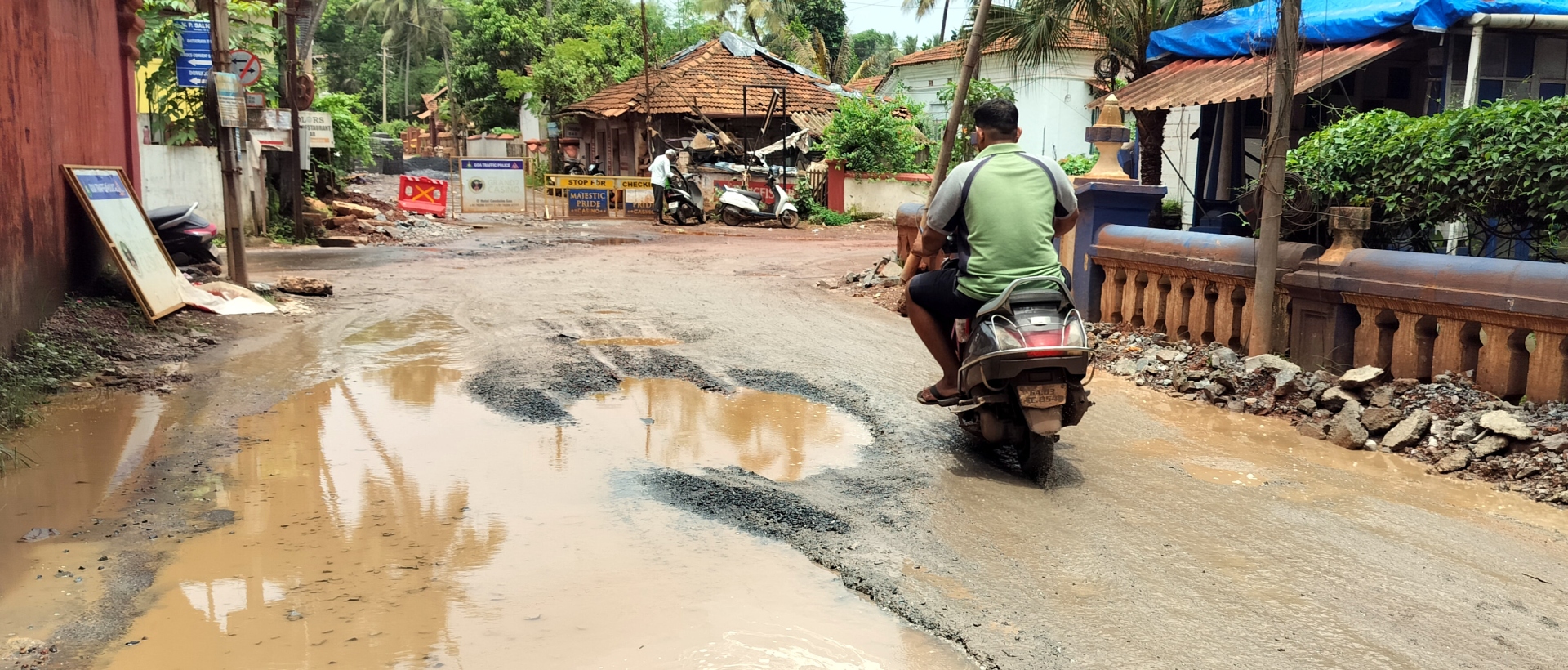Local MLA under fire as crucial road turns into monsoon nightmare

NO WAY THROUGH: A massive pothole filled with rainwater on the same Saligao road leaves motorists with barely any room to navigate.
MAPUSA
As the monsoon lashes Goa with relentless fury, a two-kilometre stretch between Saligao junction and the Pilerne Industrial Estate has turned into a veritable death trap – thanks to what locals call “criminal negligence” and “gross mismanagement” by the government and its agencies.
What was supposed to be a vital road link facilitating daily movement of schoolchildren, industrial workers, government officials and residents has now become a stretch locals dread to traverse.
The road, dug up for the second consecutive year, has once again been left in shambles by the authorities, turning it into a muddy, crater-filled, concrete-slushed disaster – right at the peak of the rainy season.
“This is not a road. This is a war zone,” fumes Pravin Naik, a resident of Saligao.
“We were assured by our MLA that the road would be restored before the rains. Instead, we now have an 800-metre stretch that can easily be termed as a killer road. If this is what development looks like, then we are better off without it,” he added.
Last year, the Water Resources Department (WRD) dug up the road to lay a water pipeline. This year, before the previous damage could be fully repaired, the Electricity Department ripped it open again – this time to lay a 33kV underground power line. The result? A road that never had a chance to breathe between cycles of destruction and patchy, half-hearted repairs.
“The right hand doesn’t know what the left is doing. We’ve been hearing of inter-departmental meetings and planning committees. But on the ground, it’s chaos. The WRD dug it up, the Electricity Department tore it open again and the PWD thought pouring a layer of concrete during heavy rains would be a good fix. It’s like a comedy of errors – only this one is dangerous,” says Rajesh Dabholkar, a social worker from the area.
In a desperate and ill-thought-out bid to make the road temporarily motorable, the Public Works Department poured concrete over the dug-up trenches just as the rains began.
But continuous downpours and the weight of vehicles moving over freshly laid concrete left deep depressions and craters. The result? Slush-filled, uneven terrain that's worse than the potholes it was meant to fix.
“The concrete was washed away like paper in a gutter. Now, not only do we have to dodge potholes, we also have to maneuver over sharp concrete edges and slippery slush. School vans have stopped plying. Parents are forced to walk their children through dangerous conditions,” said a teacher at a nearby school.
With the main road almost impassable, motorists have started diverting through internal lanes of residential areas, bringing fresh chaos to the narrow bylanes of Saligao.
Heavy vehicles like trucks and even JCBs now attempt to squeeze through private neighbourhood roads, damaging compound walls and destroying the relative peace of these areas.
“Yesterday, a JCB got stuck just outside my house. It couldn’t move forward without hitting our boundary wall. We called the police to stop such traffic, but there’s no mechanism in place. No one’s listening,” a local resident recounted.
The anger among residents is now boiling over. Many have taken to social media to slam their elected representative MLA Kedar Naik, who had promised to restore the road before the monsoon began. With no sign of accountability, residents say they feel betrayed.
“This MLA left his party and joined the ruling side claiming he wanted to bring ‘development’ to Saligao. But what we got is destruction. Is this what he had in mind when he switched sides?” Dabholkar asked.
Meanwhile, the silence from authorities has been deafening. Despite heavy criticism, no senior official from the PWD has addressed the issue or provided a concrete timeline for repairs.
The residents of Saligao are now calling for an independent audit of the entire project, demanding accountability not just from the MLA but also from department heads involved in the execution.